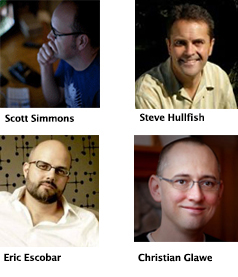 Not too long ago, Matt Jeppsen laid out how he built a 24TB RAID6 for under $2800, while Scott Simmons put together a Q and A about those hard drive docking stations we all use. Both articles underscore that strategies around backups and storage are becoming more and more important for professionals at every level. Anyone who doesn’t think through and setup a process is setting themselves up for major issues in one way or another.
Not too long ago, Matt Jeppsen laid out how he built a 24TB RAID6 for under $2800, while Scott Simmons put together a Q and A about those hard drive docking stations we all use. Both articles underscore that strategies around backups and storage are becoming more and more important for professionals at every level. Anyone who doesn’t think through and setup a process is setting themselves up for major issues in one way or another.
On the latest installment of the PVC edition of That Studio Show, Scott talks with Matt and producer/editor Jason Lyons about storage, hardware and backing up solutions. The guys get into what products and solutions they like the most, their approach when it comes to backing up client footage, the many aspects of stiction, and plenty more.
Below is a partial transcript of that conversation. To listen to the whole thing, subscribe or rate the show in iTunes or listen to the show on Stitcher Radio!
Scott Simmons: On this episode of That Studio Show, it’s another ProVideo Coalition episode where we talk about backups, storage and archive. We talk about some hardware like the Tolis Solutions, BRU software, the PreRollPost M-Logic LTO drive, Retrospect software as well as NeoFinder. We talk a little bit about backup strategies, when to back-up, when not to backup and how to deal with clients as far as archiving their footage. And we also talk about stiction. We’ve got Matt Jeppsen who is no stranger to the show with us. Matt, how’s it going?
Matt Jeppsen: I’m doing well sir, how are you?
Scott: Very well. You wrote an article awhile back about a big humongous RAID that you built that we’re going to talk a little bit about here, but we’re also joined by Jason Lyons. Jason is an editor in Nashville, Tennessee and someone that I’ve known for years because I’m also in Nashville. We talk storage and backup quite often because we have no life, but also because we share some office space. Matt was visiting the office space a couple months ago and we got into a deep discussion about archiving and backup and storage, again, because we have no life, but also because it’s important to our jobs. Jason, like myself, is a freelancer editor. He’s not the owner of a big post house nor is he some loser who just edits his kids videos, like I do sometimes. He’s got a robust backup solution and that’s what got us going on this conversation. Jason, are you there?
Jason Lyons: Hello! I am here.
Scott: Nice to chat with you, Jason. Tell us a little bit about yourself for anyone who isn’t familiar with your handle on Twitter. What is your Twitter handle?
Jason: I believe it’s @Avidzombie. I don’t use it very often but I think that’s it.
Scott: Yeah, but if someone hits you up on that you’ll reply, because you’re good about replying.
Jason: Yeah.
Matt: I think we’ve established that Jason likes to use non-conforming, obscure handles for most of his online presence.
Jason: Well, Avid Zombie is pretty much out there on Avid forums and CreativeCow, etc. By the way, I need to also mention that it sounds like we don’t have a life, but we actually do, and we like beers. I believe we were definitely into some beering when we were talking last, so I think we get a point or two for having a life.
Scott: Jason, give us a ten second bio of yourself for anyone who doesn’t know you and where you come from.
Jason: I am a producer/editor here in Nashville. I’ve been here and doing this now for 18 years. I started as a freelance guy at several post houses, and now I’m still freelance, and edit anything from a short EPK style thing to a full TV series style show. I think that’s me in a nutshell.
Scott: So you’re kind of like myself and I think part of the market of Nashville where you have to be able to do a lot of different stuff. You don’t really specialize; you generalize, due to the nature of the market itself.
Jason: Exactly. And one thing I want to add here is that I have a background in computer sales and tech support, and that helps me out a lot. I really enjoy doing the tech stuff, but boy, wouldn’t it be nice to get rid of all that and just focus on creating.
Scott: It would be nice, and I always say that you’re often able to help me with technical issues because as technical as I like to think I am there’s computer crap that I don’t know and have no desire to know. Like today we talked about checksums and I said, “Huh? What the hell is a checksum?” And you were explaining checksumming to me and how I could use it in Pathfinder, of all applications.
Jason: Yes. It looks like it’s a relatively new feature in Pathfinder and it’s one that everyone might find in ShotPut Pro. What’s the one that Red Giant makes? Offloader?
Scott: Offload, yes. They used to make one called Bulletproof that has since been discontinued.
Jason: I wonder if they have checksum? Anyway…
Scott: So let’s get into this whole storage and backup thing. Our conversation that we had when Matt was in the office was about backup and archiving. The conversation sort of went two ways. There was a discussion about how to do it, what do you do, what’s right and what’s wrong. There was also the secondary discussion of whether or not you archive everything. Do you archive all of your client media? Do you archive anything that comes into your house or was given to you to work on? And they’re two separate discussions. I first want to get into the hardware and how one backs up. Now Matt, you wrote this article, and what is that RAID that you built? You built your own DIY RAID, correct?
Matt: So I bought a RAID tower, it’s an Areca 8 bay tower, the 8050, it’s a Thunderbolt 1 tower.
Scott: That’s not G-Tech or Lacie, so would you consider that an off brand?
Matt: It’s not an obscure one you’d find on Ebay. You’d find it on OWC and other places like that. It’s probably the Nike of the off brands. It’s certainly well known in the RAID world so it’s not a cheapo thing. And there is tech support. I believe it’s a Taiwanese company. The one that I got is the Thunderbolt 1 version, which has recently been replaced with a Thunderbolt 2 version. One of the reasons I was able to built it affordably was because I bought the oldest version available, basically. It was significantly cheaper than the new one, which I think is around $1,800 without drives.
Scott: Now did you have to populate that with your own disks? Is that why it was DIY? They sent you the chassis and you shoved in the disks that you bought?
Matt: I had eight 4 TB drives that I specced out and purchased, and then installed myself. I went through the whole built, but like Jason I come from a technical background so it’s not that scary. And to be honest, it’s not that hard to do.
Scott: Now, how big is that thing and what is the RAID level for it?
Matt: I chose a RAID level 6, which gives me dual redundancy on drives failures, so I can lose up to two drives and rebuilt. What that also means is that two of my drives are not available for storage. So my eight 4 TB drives yields me just under 24 TB of storage.
Scott: Gotcha. Now, that’s a lot of space, and we had this discussion of whether you made such a large RAID because you’re so busy and you have so many projects going at once, or was the idea that you wouldn’t have to immediately clean the job off to start something else? So you could almost archive on the RAID for months at a time?
Matt: You guys both know, because we’ve all worked together. I’ve hired both of you guys on multiple occasions to do corporate work for me and other jobs as well.
Scott: And I do much better work that Jason.
Matt: (Pause) Moving on.
Jason: (Laughs)
Matt: The reason why I needed a RAID was because I had twenty plus TB of different hard drives on the shelf. They were USB externals, bus-powered externals, Firewire drives, drives that I was loading into a dock… and it was just unmanageable. I couldn’t track where files were. The impetus for it was when I was working on my commercial DP reel, and I couldn’t find stuff. I knew I had some stuff and I knew I had these files and I couldn’t find them. So my thought was to build the biggest chunk of storage I could find, put everything on that, throw away or sell all the old hard drives, and make that my everything. To put it all on there, so I only have to backup one thing.
Scott: But all of that said, at some point you do have to back that RAID up, because unless you suddenly don’t get anymore work you’ll fill that thing up.
Matt: I’m actually 1 TB away from filling it.
Jason: Oh wow.
Jason: I know, it’s funny.
Scott: So how are you going to archive off of that RAID?
Matt: I have a number of older projects from corporate clients that are from about six years ago that I don’t anticipate are going to come back calling. But if they did, it would be helpful to have a copy of this stuff, but if I didn’t have a copy of this stuff I’m not liable. You know what I mean? I’m under no obligation to keep their files, I’m doing it more as a favor to myself, so if they came back we could access them quickly. I have a number of older projects like that which can go off on disk or tape or whatever. In the case of low value stuff, where I don’t care if it dies or not because in the long run it won’t hurt me, those will probably just go on disks. I’ll probably do two copies and I’ll stick them on the shelf.
Scott: Now when you say go off on disk, are you just taking old Firewires and plugging them in or are you using drive docks? I think you’re using drive docks if I remember correctly.
Matt: Drive docks are cheaper so I use these little plastic cases that contain them. They’re shock resistant and it keeps them organized so I can label them. Something like that I would do a 5400 rpm drive because they’re a lot cheaper.
Scott: And you’re relying on spinning disk media as your archive of choice for coming off the RAID.
Matt: For things that I don’t care about that are no longer in the chain.
Scott: Gotcha. Everything else stays on the RAID, which has redundancy until you’re ready to offload to the shelf.
Matt: Correct. The RAID itself is fully backed up so I now have 24 TB of storage on my RAID, and I have 24 TB of backups for the RAID.
Scott: And is that onto drive dock mounts as well?
Matt: Currently I have 7 spinning disk backup drives in my backup archives. I use Retrospect to do a spanned backup of that 24 TB. Retrospect is smart enough to only backup what’s changed, and also knows what drives contain what data and it does all that management. It makes it very seamless for the user. It tells me, “put in disk 3, put in disk 7,” etc. So I am fully spinning disk.
Scott: The flip side of this, Jason, you are an owner of an LTO backup system.
Jason: I am a part owner, and the reason why is that they’re expensive. At least when we bought them, we purchased the Talus 24 tape library solution, and there were actually five of us that went in on the unit. The reason why it was important to me was because every year and half or so I found myself buying a new 9 TB RAID. At the time I was doing it I was using big eSATA RAIDS from Lacie, and I was wanting to stop doing that, because I wanted to get in front of that curve. As we all know, the question that comes in is, “how long do I need to keep this stuff?”
That’s just a preview of what Scott, Matt and Jason discussed during the podcast. Hear the rest about what the guys have to say around when it’s okay to delete something, why spinning disk and LTO are both viable storage options and of course, stiction.

Filmtools
Filmmakers go-to destination for pre-production, production & post production equipment!
Shop Now













